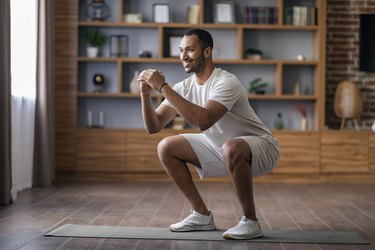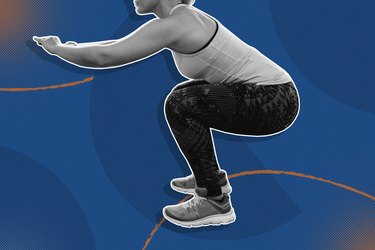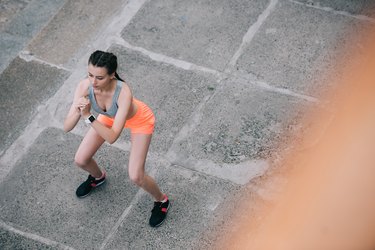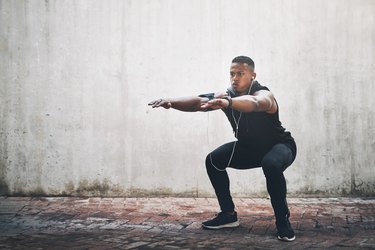
Squats have developed a reputation as a glute-building exercise — but the truth is that they strengthen almost every muscle in your lower body. When you do squats, the muscles worked include your quadriceps, glutes, hamstrings, calves and even your core muscles.
Ahead, learn about how squats target each of those muscle groups, how to do a squat with proper form, benefits of the exercise, common mistakes (and how to fix them), variations and alternatives.
Video of the Day
What Muscles Does a Squat Work?
1. Quads and Glutes
Your quadriceps and glutes are the most powerful of the muscle "engines" that drive you through the squat motion, according to the American Sports and Fitness Association (ASFA). As you're coming up out of the squat position, your quadriceps fire to straighten your legs at the knee, while your glutes straighten your body at the hips. The end result of this simultaneous action? You stand up.
The reverse happens as you sink back down into the squat: Your quadriceps and glutes both lengthen under load as you flex at the hip and the knee, a movement known as an eccentric contraction. This lengthening under load is what controls your descent and keeps you from simply plopping onto the floor at the mercy of gravity.
2. Calves
Your soleus muscle, the smaller of your two primary calf muscles, is responsible for plantar-flexing your foot (or to put it another way, pointing your toes) when your knee is bent, per the National Academy of Sports Medicine (NASM). And although your heels never come off the ground during a squat, plantar-flexion is still the motion that helps return your shin to a vertical position from the slight forward lean it assumes when you're in the "down" position of the squat.
Because your knee is bent while plantar-flexion is happening, your gastrocnemius — the bigger, meatier muscle that sits on the outside of your calf — isn't providing much power to the movement, but it does help stabilize your leg.
3. Hamstrings and Adductor Magnus
When you do squats, the muscles worked also include your hamstrings. Your hamstrings counter the direct forces of your quadriceps to help stabilize your knee, reducing shearing forces and strain across the joint, per the ASFA.
Another notable muscle, the adductor magnus, keeps your hamstrings company on the posterior (rear) part of your thigh. This muscle also kicks in to help your glutes power the movement, extending your leg at the hip.
4. Core Muscles
Because your hips hinge backward, a certain amount of forward torso lean is necessary to make squats happen — which means your core muscles all play an important part in maintaining proper squat form and preventing injury.
The further forward you lean, the more your erector spinae muscles are involved in holding your back straight, per the NASM, while your rectus abdominis (the so-called "six-pack muscle") and obliques counter the pull of the erector spinae to keep you stable.
How to Do a Squat With Proper Form
Of course, you're only going to get that sort of muscle engagement if you use proper form. Squats are an endlessly versatile exercise that you can do with only your body weight for resistance, or using dumbbells, kettlebells or a barbell for extra weight.
If you're just starting out, one or two sets of eight to 12 repetitions is a good goal.
- Stand tall with your feet hip-width apart and brace your core. Focus on keeping your feet rooted into the ground and your core tight the entire time.
- Clasp your hands in front of your chest and slowly bend your knees as you push your hips back to lower toward the floor. Focus on lowering your body as if you were going to sit on a chair.
- Lower down as far as comfortable, or until your thighs are parallel with the floor.
- Pause for a moment at the bottom of your squat.
- On an exhale, reverse the motion by pressing through your heels to return to standing. As you stand, lower your arms back to your sides.
Benefits of Squats
1. They Help Prevent Injury
Building muscle in your lower body — or anywhere for that matter — also prevents muscle imbalances and improves the strength of your bones and connective tissues (tendons and ligaments), according to the American College of Sports Medicine (ACSM). This, in turn, helps prevent injuries like fractures and tears in your bones, connective tissues and muscles.
2. They Help You Perform Real-World Activities
You may not realize it, but you perform squats in everyday life when you sit down in a chair or bend down to pick something up. So, adding squats — and other lower-body exercises — to your workout sessions help strengthen the muscles responsible for aiding in these everyday tasks, according to the ACE.
3. They Help Give Your Performance a Boost
"Strong, powerful glutes help you jump higher and run faster," per the ACE. So, if you play sports that involve these actions, regularly doing squats will help improve your overall performance in these areas.
Common Squat Mistakes (and How to Fix Them)
Squat injuries are often caused by mistakes in form — so it's worth going over a few key issues to avoid. Some common mistakes to avoid, and their fixes, include:
1. Letting Your Knees Cave Inward
Reduce the amount of weight you're lifting and use a mirror or a lifting buddy for feedback as you focus on keeping your knees "up" instead of letting them sag in. It might help to pay close attention to your feet: Sometimes reminding yourself to push through your entire foot (instead of just the inside edge) will help correct this.
Here's another useful cue that might help: Your toes should point straight forward or slightly out and, from your perspective as you look down the length of your body, your knees should always point in the same direction as your toes.
2. Not Hinging at the Hips
Some people try to do squats without leaning forward from their hips at all — but this places a lot of pressure on your knees, according to the ACE. Your hips actually start the motion, moving down and back, which in turn requires your knees to bend and your torso to tilt forward slightly.
3. Lifting With Your Back
Have you ever heard the directive "Lift with your legs, not your back"? That certainly applies to squats — so, when you begin to stand back up, think of pressing through all of both feet and driving with your legs to initiate the motion. If you try to start the motion in your back instead, you'll get hurt.
Should You Use a Smith Machine for Squats?
Whether or not Smith machines are an acceptable tool for doing squats is a subject of some controversy. The Smith machine has a couple of very useful safety features, such as height-adjustable stoppers that will support the bar if you get "stuck" at the bottom of the squat, and a self-spotting hook on the bar that you can rotate to lock the bar in place. Like the adjustable stoppers, this gives you a graceful (and potentially injury-avoiding) "out" in case of emergency.
But more to the point, a Smith machine also traps the bar in a vertical track. While not everybody will feel comfortable with this vertical range of motion, it can be helpful for beginners who are familiarizing themselves with the motion, who don't have a spotter available or who feel pain doing normal barbell squats, because the motion-restricted bar allows you greater flexibility in where you put your feet.
Ultimately, the best way to see if the Smith machine will suit you (or not) is to give it a try.
Squat Variations
You'll find almost endless variations on the squat, usually based on where you place your feet, what sort of weight you use or where you hold the weight. A few key variations to be aware of include:
1. Front Squat
In this exercise, you hold the barbell across the fronts of your shoulders. As confirmed by EMG (electromyography) analysis in a small January 2015 study of 12 participants, published in the Journal of Sports Sciences, the front squat emphasizes quadriceps activity and decreases trunk lean. That makes it potentially a good choice for those with back concerns, but a poor choice for those with knee issues.
- Stand with your feet slightly wider than hip-width apart, toes turned slightly outward and a barbell resting on the tops of your shoulders on the front side of your body.
- Hold the bar with an underhand grip, palms facing the ceiling and hands next to your shoulders.
- Engage your core, then on an inhale, sit back into your hips and bend your knees to lower your body until your thighs are parallel to the floor (or as low as you can comfortably go).
- Keep your chest up and avoid rounding your back.
- On an exhale, press through your feet to straighten your legs and return to standing.
Tip
The goblet squat, in which you hold a single kettlebell in front of you by the "horns" or handle, is a variation on the front squat.
2. Sumo Squat
You can do squats with an increasingly wider stance until you hit the wide, toes-out stance of the plié squat — as long as you follow the cardinal rules of proper form: Your knees must always point in the same direction as your toes, and don't let your knees cave in toward your midline.
A wide stance emphasizes the involvement of your hip adductors, or inner thigh muscles, per an ExRx.net squat analysis. Glute activity increases when you do sumo squats with a heavy load, and it's worth noting that hip torque (force) increases as well — so if you struggle with hip pain, this probably isn't the squat variation for you.
- Stand with your feet slightly wider than hip-width apart, toes pointed out at a 45-degree angle. (If the position feels uncomfortable, move your feet in a little closer).
- Clasp your hands together at your chest.
- Keeping your back straight, push your hips back and bend your knees out over your toes to squat down. Thinking about sliding down a wall, keeping your back as straight as possible and avoiding leaning forward or sticking your butt out.
- Lower until your your thighs are parallel to the floor (or as low as you can go).
- Activate your core, glutes and quads to propel your body back upright, driving your weight through your feet to return to a standing position.
- Squeeze your glutes at the top of the movement and repeat.
3. Dumbbell Squat
Doing your squats with dumbbells means giving up some of the overall stability of the barbell — but in return, you get more flexibility in the way you hold the weights. Two of the most common dumbbell squat variations are letting your arms rest by your sides (so the dumbbells "ride along" on the outsides of your body throughout the squat) or holding the dumbbells racked at shoulder level. The latter more or less mimics the positioning of a barbell, but gives you greater flexibility in the angle at which you hold your hands.
- Stand with your feet about shoulder-width apart. You can turn your toes slightly out or point them straight ahead. Hold dumbbells at your sides, palms facing in.
- Fill your chest with air to set your core. Maintain a tight, vertical torso throughout the movement with a natural arch in your low back.
- Push your hips back and bend your knees to lower down until your thighs are parallel to the floor. Keep your chest up and your weight in your heels.
- Push your feet into the ground to stand back up.
- Repeat.
4. Goblet Squat
Another dumbbell variation is a goblet squat, where you hold a single weight by one end and let it dangle between your legs as you squat. This variation sometimes makes it easier for beginners to achieve proper form, and it allows you to do wide squats. But, depending on the size of the weight you're using, the lower end of the weight may contact the ground and thus limit your range of motion.
- Hold a dumbbell or kettlebell against your chest with both hands. If using a dumbbell, place your palms under the weight at one end rather than holding the handle. If using a kettlebell, grip the handles near the base.
- Stand with feet hip-to-shoulder-width apart. Experiment to find the stance that’s most comfortable for you.
- Keeping your chest up and core engaged, sit the hips back and bend your knees to lower into a squat. Your knees should track over the toes.
- Aim to squat until your thighs are parallel or nearly parallel to the floor.
- Keeping the weight in the heels, straighten the knees and drive through the hips to return to the starting position.
- Repeat.
5. Overhead Squat
Overhead squats are an advanced squat variation that require a lot of shoulder and ankle mobility so you can keep the barbell pressed straight up overhead while doing the exercise.
- Stand with your feet about shoulder-width apart with your toes pointed straight or slightly outward.
- Place the barbell in the front-rack position so the bar rests across the front of your shoulders and your elbows point straight forward. Brace your core.
- Bend your hips and knees slightly, then press through your feet to extend your legs and press the barbell overhead, locking out your elbows to keep it pressed up.
- With the bar overhead, continue to brace your core and keep your back straight and upright as you push your hips back and down into a squat.
- Lower down until your thighs are parallel to the floor (or as low as you can comfortably go with good form).
- From the bottom of your squat, push through your feet to extend your legs and stand back up.
6. Jump Squat
Jump squats are an explosive move, which causes your heart rate to spike. This means your cardiovascular system benefits more from this exercise.
- Stand with your feet shoulder-width apart and your toes facing forward or slightly outward.
- Keeping your feet flat on the floor and back straight, brace your core and push your hips back and down until your thighs are parallel to the floor (or as low as you can comfortably go).
- From the bottom of your squat, push through your feet to jump explosively off the ground. (You can extend your arms down along your sides as you do.)
- Land safely with your knees slightly bent.
7. Back Squat
Barbell back squats strengthen your quads without putting as much stress on your knees, making them good for people with knee issues. Make sure you rest the barbell on your traps versus your neck, or else you risk pain and/or injury.
- Stand with feet slightly wider than hip-width apart, toes turned slightly outward and a barbell resting on the tops of your shoulders on the back side of your body.
- Hold the bar with an overhand grip, palms facing forward and hands next to shoulders.
- Engage your core, then on an inhale, sit back into your hips and bend your knees to lower your body until your thighs are parallel to the floor (or as low as you can comfortably go).
- Keep your chest up and avoid rounding your back.
- On an exhale, press through your feet to straighten your legs and return to standing.
Tip
Make sure you put weight collars on your barbell if you add weight plates. These spring-loaded clips stop the weight plates from sliding off if you tip the bar to either side.
Weighted Squats vs. Back Squats: What's the Difference?
While both weighted squats and back squats involve some sort of piece of equipment to add resistance, the two types of squats are actually a bit different. With weighted squats, you can hold a dumbbell or kettlebell at your sides, in front of your chest or at your shoulders as you squat. With back squats, you hold a barbell that's resting against your upper back as you squat.
Squat Alternatives
If you can't perform squats or any of their variations due to pain or injury, there are alternative exercises you can do that work the same muscles. Here are a few options you can do anywhere.
1. Reverse Lunge
Because there's less demand on your knees, the reverse lunge is the most joint-friendly type of lunge. This makes it a great choice for beginners or those coming back from injury.
- Start standing tall with both feet together.
- Initiate the movement by stepping back behind you with one foot. You should step far enough back that your front knee forms a 90-degree angle (or a little less) as you go down, but not so far that your back knee is way behind your hips.
- Drop down in a controlled manner, stopping with your back knee about 1 inch from the floor. Keep your hips and knees level and don't allow your body to rotate or shift from side to side.
- Finish the rep by driving your front heel into the ground, standing up tall and bringing both feet back together.
- Be sure to do all the reps on both sides.
2. Step-Up
Step-ups use your lower body in a different way than squats, so if you can't do squats without pain, you may be able do step-ups as a squat alternative. Start with a box where your thigh is no higher than parallel with the ground.
- Stand facing a box or bench.
- Place one foot flat on the top of the box. Don't allow your heel or any other part of your foot to hang off the box.
- Lean forward slightly and push your foot down into the box. Imagine you're trying to crush an aluminum can with your foot. Push yourself all the way up with this leg until you're standing tall.
- Once you stand up fully, you can lightly place the other foot on the box as needed for balance.
- Finish the movement by lowering yourself down to the ground in a controlled manner. The leg that you stood up with should be the same leg that lowers you back down.
- Be sure to do all the reps on both sides.
3. Glute Bridge
The glute bridge is a great squat alternative because you still have to push through your lower body, but it doesn't put as much stress on your joints as a squat.
- Lie on your back with your knees bent, arms on the ground and feet flat on the floor.
- Initiate the movement by driving your heels into the floor. Squeeze your butt tight and raise your hips up into a bridge position.
- Don't hyperextend your hips or lower back at the top of the bridge. When viewed from the side, your body should form a straight line through your shoulders, hips and knees.
- Hold the bridge for 1 to 3 seconds before returning your hips back to the floor.
- ExRX.net: "Barbell Squat"
- American Council on Exercise: "Myths and Misconceptions: Lunges and Squats"
- Journal of Sports Sciences: "Kinematic and EMG Activities During Front and Back Squat Variations in Maximum Loads"
- ExRx.net: "Author's Analysis of Smith Squat"
- ASFA: "Understanding the Biomechanics of a Squat"
- NASM: "THE MUSCLES USED IN SQUATS - SQUAT BIOMECHANICS EXPLAINED"
- ACE: "Debunking Fitness Myths: Squats"
- ACSM: "Resistance Training and Injury Prevention"
- ACE: "5 Ways to Supercharge the Squat"
- ExRx.net: "Squat Analysis"


